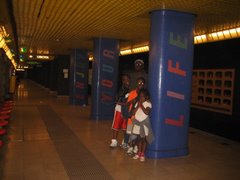
The children and I visited the necropolis at Cerveteri on their day home last Friday. The huge, Etruscan tombs were made of tufa (a volcanic rock from which our home also is made). They were surprisingly inspiring. Similar to Egyptians, Etruscans built the tombs to prepare for life-after-death and often resembled very clean homes--they included chairs, vases and art. In Etruscan Places, DH Lawrence wrote of his visit:
“We went down the few steps, and into the chambers of rock within the tumulus. There is nothing left, it is like a house that has been swept clean, and the inmates have left. Now it waits for the next comer. But whoever it is that has departed, they have left a pleasant feeling behind them, warm to the heart. The tombs seem so easy and friendly, cut out of rock underground. One does not feel oppressed descending into them. There is a simplicity combined with a naturalness and spontaneity. Death to the Etruscans was a pleasant continuance of life with jewels and wine and flutes playing for the dance.”
 The children were most fascinated with the florescent yellow water that flooded a number of the tombs. We never figured out what kind of chemical caused that or what it's for...
The children were most fascinated with the florescent yellow water that flooded a number of the tombs. We never figured out what kind of chemical caused that or what it's for... Etruscans were remarkable. They built sewage systems, arches and roads and, later, taught the Romans. Romans refined and spread many of these technologies all over Europe, North Africa, and the Byzantine world as their empire increased.

